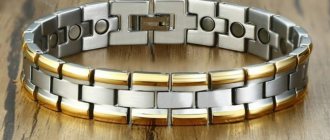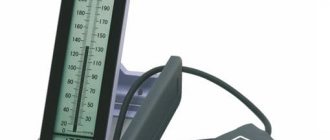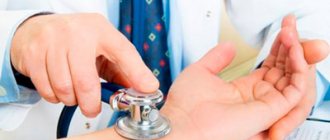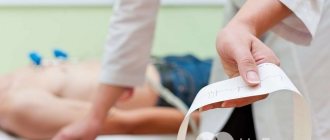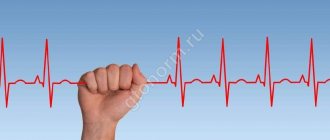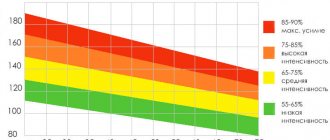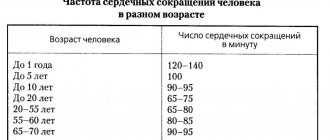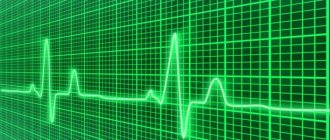In this article:
- What is pulse?
- Correct measurement algorithm
- How to measure pulse using a tonometer?
- How does a pulse oximeter work?
- Benefits of a heart rate monitor
- What can fitness bracelets do?
- Pros of using devices
- How to evaluate heart rate?
Pulse measurement is the easiest and most accessible way to assess the condition of the cardiovascular system. You can determine your indicator at home, while walking, or in any other circumstances. To calculate your heart rate manually, a regular watch with a stopwatch is sufficient, but you can also use modern gadgets that will determine and store the resulting value in memory.
How regular running, swimming, cycling, skiing affect your resting heart rate
Regular endurance training in sports such as running, skiing, swimming, cycling leads to athletic adaptation of the body and especially the cardiovascular system.
When engaging in cyclic sports, the amount of fat in the body decreases, cholesterol levels decrease, and the proportion of so-called high-density lipoprotein cholesterol increases - along with it, the ability to resist cardiovascular diseases increases.
In addition, the volume of the heart and lungs increases, and the blood vessels dilate. Particularly interesting metamorphoses occur with the heart. Its density increases, the muscle walls become thicker. In athletes, during physical activity, the heart beats less often, but stronger, which is associated with the increased volume (or capacity) of the left ventricle of the heart. This makes it easier for the heart to pump blood throughout the body with each beat, which leads to a decrease in resting heart rate.
A heart that has undergone such changes during adaptation is called “sports”, and this is a normal phenomenon when getting used to physical activity. Interestingly, this condition was previously considered a pathology.
What is pulse?
First, you need to define the basic concepts, figure out what and why you will measure. Not everyone knows that heart rate and pulse are not the same thing. The first indicator reflects the number of contractions of the ventricles of the heart per minute, i.e. how many times during this period the ventricles filled with blood and pushed it into the aorta and pulmonary artery. And the pulse is the number of vibrations in the walls of the arteries that occur due to contractions of the heart.
In a healthy person, these indicators are the same, but in some pathologies they may differ. The norm for an adult is a pulse rate of 60-90 vibrations per minute; in children, the indicator is determined by age. The younger the child, the faster his pulse. When measuring the pulse, the doctor determines several parameters:
- Frequency;
- Filling;
- Voltage;
- Height;
- Rhythm;
- Form.
By taking measurements yourself, you can only find out the frequency. But this indicator also allows you to evaluate the work of the heart, choose the right physical activity, and notice changes in time.
What should an adult’s pulse be like: normal and pathological
What is the pulse like? What do its values depend on? Is the pulse always equal to the heart rate?
Physician, cardiologist at Clinic Expert Voronezh, Angelina Anatolyevna Kalinina, helped us find answers to these and other questions.
— Angelina Anatolyevna, what is a pulse and what does its frequency depend on?
The pulse is a rhythmic oscillation of the walls of the arteries, associated with the entry of a certain amount of blood into them during the contraction of the heart and a change in pressure.
Heart rate is affected by:
— level of physical activity (rest, exercise);
— condition of the heart muscle and valves;
- blood pressure value;
— work of the neuroendocrine system;
- level of basal metabolism (one of the criteria is body temperature).
BECAUSE THE PULSE MAY BE IRRHYTHMIC, IT IS RECOMMENDED IN ALL CASES TO COUNT IT FOR NO LESS THAN 60 SECONDS
A situational increase in heart rate is possible when taking certain substances (both medicinal and toxic), and this also happens in a person in a positive and negative emotional state (joy, fear, anger, etc.).
— How to measure the pulse correctly?
Mainly by palpation (feeling) of the vessel. The pulse can be counted in the radial, carotid, temporal, and femoral arteries. But in practice, the radial artery is most often used.
The wrist of one hand or another is covered with the fingers in the area of the wrist joint, the artery is felt, pressed with 2-3 fingers, and the pulse is counted.
Read the material on the topic: What should a child’s blood pressure be?
Usually the pulse is counted for 1 minute. In the literature you can find measurement methods where the pulse is calculated for 15 seconds and then multiplied by 4, or for 30 seconds and then multiplied by 2. However, due to the fact that the pulse can be irregular, it is recommended in all cases to count it at least than within 60 seconds.
— In Chinese medicine, there is a diagnostic method based on the pulse. In fact, what can the pulse tell you?
Indirectly, the pulse can be used to judge the heart rhythm (and its disturbance), the state of the myocardium, heart valves, blood vessels and vascular wall, the level of basal metabolism, the functioning of the autonomic nervous system, and the emotional state of a person.
Read material on the topic: Heart, why don’t you want peace? What causes tachycardia?
— What should be the normal heart rate of an adult?
According to various sources, normal levels in adults range from 60-80, 60-90 beats per minute. The number of pulse beats is equal to the heart rate (HR), i.e. Normally, there should be no so-called pulse deficit (a situation when its frequency is less than heart rate. This occurs, for example, with atrial fibrillation). In addition, the normal pulse is rhythmic, symmetrical, with satisfactory filling and tension.
— What affects a person’s pulse? What factors does it depend on?
There are several factors. The symmetry of the pulse is affected by a decrease in the lumen of one of the arteries, its incorrect location (the radial one itself, or the overlying ones, the radial branch of which is), compression of the artery (for example, an aortic aneurysm, a neoplasm, enlarged lymph nodes).
NORMALLY IN ADULTS, THE PULSE VALUES WITHIN 60-80, 60-90 BLOCKS PER MINUTE
Pulse is also influenced by heart rate; the adequacy of the contractility of the heart and the amount of blood ejected into the aorta during contraction of the left ventricle; condition of the artery wall; operation of the valve apparatus.
- For what reasons can the pulse decrease?
If this means a decrease in heart rate, then normally this is possible during intense sports training, in a state of sleep.
A rarer, slower pulse, as an indicator of pathology, may occur with certain disorders of the rhythm and conductivity of the heart, aortic valve stenosis, a disorder of the autonomic nervous system, poisoning, and certain infectious diseases (typhoid fever, brucellosis).
Read the material on the topic: Is there a diagnosis of vegetative-vascular dystonia?
Taking certain medications (beta blockers, antiarrhythmic drugs) can reduce your heart rate.
- If the pulse is low, does this mean that the person has low blood pressure?
If by low heart rate we mean rare, then such a relationship does not always happen. There are situations when the pulse is low and the blood pressure is high.
Read the material on the topic: For what reasons can blood pressure be low?
— Under what conditions can the pulse be high?
If a high pulse is understood as its increase, then the cause may be physical activity, stress, consumption of caffeine-containing drinks, or a number of medications (for example, aminophylline, nifedipine, cordiamine, salbutamol, atropine).
A frequent pulse can occur in various pathologies: diseases of the cardiovascular system (rhythm and conduction disorders; damage to the myocardium and pericardium, valvular apparatus; heart failure), dysfunction of the autonomic nervous system with a predominance of the influence of its sympathetic department, most infectious diseases, diseases of the endocrine system ( thyrotoxicosis), bleeding from the gastrointestinal tract, pulmonary edema, pulmonary embolism, shock and a number of others.
— Angelina Anatolyevna, is a high pulse always accompanied by an increase in blood pressure or is this not necessary?
No, this doesn't always happen.
Read related material: The Ultimate Guide to High Blood Pressure: Frequently Asked Questions
— What heart rate indicators require urgent medical attention?
Pulse parameters in themselves are not always a reason to urgently consult a doctor. However, if a decrease or increase in heart rate is accompanied by any symptoms (for example, with a low pulse, dizziness and loss of consciousness are noted), then you should immediately consult a doctor.
— How to provide first aid at home to a person who has a high or low pulse?
It is necessary to clarify whether such conditions have occurred before, what they were associated with, how they were tolerated; What diseases does he suffer from and have suffered in the past?
You should definitely ask about the person's medications: it is possible that he forgot to take a medicine (for example, a beta blocker), which is why his pulse quickened. Taking the drug in this case can be first aid.
AN IMMEDIATE CALL OF AN AMBULANCE IS NECESSARY IF THE CONDITION OF HIGH OR RARE PULSE HAS DEVELOPED FOR THE FIRST TIME, ESPECIALLY IF THE PERSON HAS PREVIOUSLY HAD SOME DISEASES
If you have a tonometer and thermometer, measure your blood pressure and body temperature. Reducing high numbers for both indicators can also have a positive effect on your heart rate.
In case of stress or autonomic dysfunction, it is necessary to try to calm the patient. Taking one of the drugs such as valocordin, corvalol, valerian, motherwort may help.
If the pulse is low, it is better if the person lies down. Of course, you need to lie down even if your pulse is high, if this condition is accompanied by general weakness, a feeling of lightheadedness, or dizziness.
If a low pulse is accompanied by low blood pressure, you can drink tea or coffee.
If there are no positive changes, you must call an ambulance. In addition, an immediate call is also needed in the case of an increase or decrease in heart rate that develops for the first time (and especially suddenly); progressive deterioration of health, especially in a person who has had certain diseases previously (for example, heart rhythm disturbances, myocardial infarction or stroke, gastrointestinal bleeding, pulmonary edema, pulmonary embolism).
Subscribe to our materials on social networks: VKontakte, Odnoklassniki, Facebook
For reference:
Kalinina Angelina Anatolevna
In 2007 she graduated from the Voronezh State Medical Academy named after. Burdenko.
From 2007 to 2008 she completed an internship in therapy, in 2010 she underwent professional retraining in the specialty “General Medical Practice (Family Medicine)”, and in 2017 – in the specialty “Cardiology”.
Since 2015, he has been working as a general practitioner, and since 2021, as a cardiologist at Clinic Expert Voronezh. Reception is conducted at the address: st. Pushkinskaya, 11.
Correct measurement algorithm
There is a simple heart rate measurement algorithm that can be used in any circumstances. The pulsation can be clearly felt on the wrist, and equally on both hands. For such a measurement, several conditions must be met:
- Place your wrist at heart level in the palm of your other hand;
- Feel the pulse on the palmar side along the edge where the thumb is located (on the side of the little finger the pulse is usually not audible, this is due to the location of the radial artery);
- Wrap your fingers around your wrist so that your index finger is closer to the wrist joint;
- Apply gentle pressure with your fingertips on the wrist in the direction of the radius.
In this case, the middle and index fingers should feel the pulse wave - rhythmic vibrations of the artery wall. It is necessary to note the time and count the number of beats per minute.
Alternatively, you can measure your pulse in your neck. To do this, you need to find the carotid artery: run your fingers from the back corner of the lower jaw down the neck. However, it is believed that determining the pulse on the hand is more comfortable, and its results are more accurate.
General recommendations for preparing for heart rate measurement
Doctor taking pulse
Before measurement, it is necessary to exclude any physical activity, as it leads to a rapid heartbeat. You should not drink alcohol, coffee, tea. You also need to stop smoking a few hours before the measurement. Hot baths, steam rooms, and saunas can also affect your heart rate readings. Hunger or overeating can also affect the accuracy of the indicators.
In addition, it is not recommended to measure pulse if a person:
- is in emotional overexcitement;
- just woke up from sleep;
- dressed in constricting and tight clothing.
Vibration indicators of vessel walls can be determined by two methods: using a device, palpation. If you know the correct algorithm, the results will be quite accurate.
How to measure pulse using a tonometer?
You can use special instruments for measurements. There are several options to check your pulse and at the same time find out some other important indicators. One of them is a tonometer. Such a device records pulse and blood pressure, and modern models are capable of:
- Save results in memory;
- Compare indicators with the norm, identify deviations;
- Calculate average values for a certain period;
- Transfer information through applications to mobile devices or to a computer, where you can conduct a full analysis, including using graphs and diagrams.
To get accurate results, you need to take measurements correctly. Measurements are taken in a sitting position, the cuff on the arm should be at the level of the heart. It is important to calm down and comply with all the requirements listed in the instructions for the device.
Automatic blood pressure monitors inflate the cuff themselves and take measurements. The user can only estimate his pulse and pressure using the numbers on the display.
How does a pulse oximeter work?
Another modern pulse device is a pulse oximeter. Its functions are to determine saturation and count the heart rate (pulse rate). This is a medical device, before using it you need to understand the features of its use.
So, pulse oximeter – what is it and how does it work? The device is equipped with two light sources with different wavelengths and a photosensor that detects the reflection/absorption of light waves by various tissues. The light is partially reflected/absorbed when passing through soft tissues and blood, this makes it possible to determine saturation - the saturation of arterial blood with oxygen as a percentage. The normal rate varies from 95% to 100%; lower values indicate malfunctions in the functioning of the body systems.
To measure your pulse with this device, you need to attach the sensor to your fingertip, press the button and wait a few seconds. The display will show two indicators simultaneously: pulse and saturation. If the values are outside the normal range, a beep will sound.
Diagnostics by pulse
During the ruling Chinese dynasty, pulse diagnosis was widely used to determine the condition of a monarch. The doctors could touch them only to measure his pulse. An incorrect diagnosis cost the healer his life. And they counted the frequency, uniformity and strength of the monarch’s heart contractions. They were diagnosed.
For diagnosis by heart contractions, the frequency of beats, their strength, and fullness are still taken into account. For example, place three fingers of the right hand in the place of the left wrist, where the radial artery is located, so that the heart contractions are felt by each finger. They remember under which finger the blows are felt more strongly. The same is done with the left hand.
If, when pressed in the left wrist, the heart beats under the pad of the index finger, this is a signal of a disease of the small intestine in a man, and a disease of the large intestine in a woman. The depth of the beats under the same finger indicates the condition of the heart in men or lungs in women.
Deep palpitations in the wrist of the right hand indicate pathologies of the lungs in men and heart pathologies in women. Similarly, superficial heartbeats indicate pathologies in the intestines, but, on the contrary, from pathologies of the left hand.
It is impossible to accurately measure blood pressure using heart rate readings alone, but you can find out whether your blood pressure is high or low. It disappears for a few seconds, and then the pulse appears again due to arrhythmia. With osteochondrosis, the frequency of impacts on different hands is different.
Benefits of a heart rate monitor
Tonometers and pulse oximeters are medical devices and are convenient to use at home. But many convenient gadgets have been created for people who prefer an active lifestyle. There is even a special device for measuring pulse, which is called a pulsometer.
Basically, devices of this type look like a wristwatch and are used to assess the effectiveness of physical activity by measuring heart rate. In addition to counting your pulse, heart rate monitors perform many useful functions:
- Calculate the average heart rate;
- Determine the maximum values;
- Allows you to set up an individual training zone and notifies you when you go beyond it with an audible signal;
- Equipped with a countdown timer;
- Show date, time, day of the week;
- Works as a stopwatch and alarm clock;
- They are synchronized with special software to transfer data to a phone or computer, where the dynamics can be analyzed.
Many devices provide additional functions, for example, determining the height or number of laps while running, calculating energy consumption, recording the acceleration of the legs, and others. Some models are equipped with a chest belt. The main advantage of heart rate monitors is the most accurate pulse determination, comparable to ECG data.
What can you understand by measuring your morning pulse?
If you regularly measure your pulse in the morning, for example, for a week, you can:
- get an idea of the body’s adaptation to stress;
- you can see how regular running, swimming, cycling, skiing - any cyclic sports - affect heart training;
- assess the quality of restoration;
- track the onset of overtraining;
- track the onset of the disease;
- understand the level of stress in life;
- understand how acclimatization occurs in the mountains (if you find yourself there).
Tracking athletes' morning heart rate is becoming an important marker for assessing training. Every serious athlete records their resting heart rate in a diary, which also displays their heart rate zones during training. These indicators are assessed by the trainer, since an increased or decreased heart rate may indicate problems, insufficient or excessive training volume.
And it is the pulse that is used as a guide when undergoing acclimatization in the mountains, be it training at altitude or climbing. After rising to a height, the body adapts to “pump” blood throughout the body in conditions of less oxygen supply and increased pressure. A morning heart rate returning to normal indicates that acclimatization has taken place and you can continue training or climbing.
Training plans for marathon and half marathon. and start preparing today.
Read on the topic: Pulse zones: what heart rate to run at
photo: Nastasic/Getty Images, source: runnersworld.com
What can fitness bracelets do?
One way to check your pulse and get a lot of other useful information is to use fitness bracelets.
The compact device is fixed on the wrist according to the same principle as a watch. It doesn’t interfere with work, walking, training, and it’s even comfortable to sleep with. All this time the device measures:
- Number of steps taken and distance in km;
- Duration of sports training;
- Achievement of set goals in %;
- Volume of calories burned;
- Duration and quality of sleep.
The range of options depends on the model. For example, some devices synchronize with a smartphone, inform about incoming calls and messages, and transfer the results of all measurements to a mobile device for subsequent analysis. All fitness bracelets function as watches and alarms.
High resting heart rate: what to do
When the resting pulse is elevated and this is not due to objective reasons (age, gender, etc.), you can try the following:
- Quickly calm down or cool down by drinking a glass of cool water and doing breathing exercises - for example, inhaling deeply for 5 seconds and exhaling for 3 minutes.
- If the increase in heart rate is associated with emotions, try the psychological method of “grounding.” You need to get up and walk around the room or on the street, concentrating on momentary sensations, such as your foot touching the ground, and on what you see around you.
- A high morning heart rate indicates under-recovery - you need to get better sleep and reduce stress.
- If your heart rate has dropped or risen due to overtraining, rest and change your training plan.
- A resting pulse that is too low may indicate bradycardia, while a resting pulse that is too high may indicate tachycardia. Only a doctor can recognize and solve these problems.
Read on topic: Running at low heart rate: how and why to train at low intensity
Pros of using devices
Such devices are very popular due to their many advantages:
- A person can always evaluate his physical activity and, if necessary, adjust it;
- Calorie counter helps you stay fit;
- Heart rate measurement is carried out in real time with high accuracy;
- The cost of the devices is quite affordable;
- The bracelets look stylish and elegant;
- The device combines many useful functions.
In addition, fitness bracelets are easy to use. With their help, it is convenient to monitor your pulse during training without being distracted by taking measurements. Just place your finger and wait a few seconds for the measurement result.
Calculation formulas
There are formulas for calculating the maximum heart rate, which are based on the age and gender of a person, but one must understand that they give a certain error, since the value of the maximum heart rate depends on the individual characteristics of the body of a particular person, and not just on age and gender.
Formulas based on age
| Haskell-Fox formula (used since 1970) | Maximum heart rate = 220 – age |
| Laundery-Meshberger formula | Maximum heart rate = 206.3 – (0.711 x age) |
| Tanaka formula (derived in 2001, considered the most accurate) | Maximum heart rate = 208 – (0.7 x age) |
| Miller's formula | Maximum heart rate = 217 – (0.85 x age) |
| Roberges-Landwehr formula | Maximum heart rate = 205.8 – (0.685 x age) |
| Jackson's formula (developed in 2007) | Maximum heart rate = 206.9 – (0.67 x age) |
Formulas taking into account age and gender
| White's formula | men: Maximum heart rate = 202 – (0.55 x age) |
| women: Maximum heart rate = 216 – (1.09 x age) | |
| Ball State University Formula | men: Maximum heart rate = 214 – (0.8 x age) |
| women: Maximum heart rate = 209 – (0.9 x age) | |
| Martha Gulati Formula (published 2010) | women only: Maximum heart rate = 206 – (0.88 x age) |
| Astrand's formula | men: Maximum heart rate = 220 – age |
| women: Maximum heart rate = 226 – age |
How to evaluate heart rate?
Self-monitoring your heart is quite easy, especially with heart rate bracelets and other smart devices. But it is also important to evaluate the results correctly. To do this, you should take into account several nuances:
- The normal pulse at rest is 60-80 beats per minute;
- For women, the rate is 5-10 beats higher;
- The pulse in a lying position is minimal, in a sitting position it increases by 4-6 beats, while standing - by 10-14 beats per minute;
- In winter, the rate may be lower than in summer;
- Throughout the day, the pulse changes from the slowest at night to the maximum at 18-20 hours, increasing at 8-12 hours and about 15 hours, but it all depends on the daily routine of a particular person;
- After eating hot food and drinks, the pulse quickens.
Heart rate is related to physical activity: the more intense it is, the higher the indicator will be. During active sports, the heart rate increases to 150 beats per minute. A level of 200 blows is considered critical; at this level, the load must be reduced. In athletes, the heart muscle is more trained, so the heart rate during exercise grows more slowly than in an ordinary person.
Before checking the pulse on your hand or assessing the performance of special devices, it is worth considering the factors that influence the heart rate. The pulse increases not only due to physical activity. This effect can be caused by stressful situations, overeating or severe hunger, drinking alcohol or smoking, and even massage.
A heart rate deviation of 10% or more from normal may be a cause for concern. For example, if you have a constant rate above 90 beats per minute under the age of 30, you should consult a cardiologist. A decrease to 50 beats or below may also indicate the development of pathological processes in the body. A drop to 40-35 beats indicates a real threat to life.
Pulse measurement allows you to monitor the condition of the body, obtain objective indicators of the functioning of the heart and blood vessels, and promptly identify deviations. You can determine the indicators yourself manually or using special devices that monitor the pulse automatically with high accuracy.
Measurement with a heart rate monitor
How to measure pulse with the device?
There are different types of heart rate monitors: mounted on a finger, on the chest or shoulder. Such devices are often used by athletes to automatically and quickly collect data on heart function.
First you need to secure the device and turn it on. After the device takes a measurement, the result will appear on the screen. This is a very simple and easy way.
Important! Special devices used in the clinic for diagnostics are also capable of measuring the pulse. This indicator can be determined using ultrasound scanning, phonocardiography, and Doppler examination.
